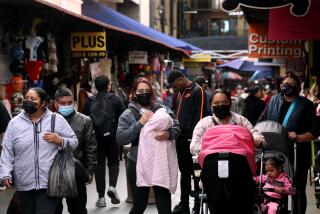Heart Disease Data Vary by Area, Study Finds
- Share via
Counties in the Central Valley and Southern California have a higher rate of hospitalization for heart disease than elsewhere in the state, according to the state’s most comprehensive study of the issue.
In addition, the study found that many of those counties also have significantly higher hospitalization rates for stroke.
Researchers from UC San Francisco and the state Department of Health Services said they cannot explain the geographic variations, but suspect that access to health care, environmental pollution and lifestyle may play roles.
Cardiovascular disease, which includes coronary heart disease and stroke, is the No. 1 killer in the state, causing 42% of all deaths. Coronary heart disease and stroke account for one out of three deaths in the state. Stroke is also the leading cause of disability in the nation.
The study showed that 10 counties--with Merced, Tulare and Kern topping the list--had coronary heart disease hospitalization rates that were significantly higher than the state average. Merced County residents’ hospitalization rates for coronary heart disease, for instance, were 1.9 times higher than those for residents of Santa Barbara County, which had the lowest rate.
Counties with the highest hospitalization rates from stroke were Tulare, Los Angeles and Alameda.
“This report is really designed to be used as a screening tool to map out what’s going on around the state,” said Jeannie Gazzaniga, lead author of the report and an epidemiologist at UC San Francisco’s Institute for Health and Aging. “From these kinds of analyses, people start to think, ‘That’s my backyard. What can I do about it?’ ” she said.
“These results are not acceptable,” said Dr. Jonathan Fielding, director of public health for Los Angeles County, which ranks seventh in the state for coronary heart disease hospitalizations and second for stroke. “From a public health standpoint, it means we need to redouble our efforts to control these chronic diseases. While we don’t know exactly what these differences are attributable to, there is abundant evidence of key risk factors for heart disease, such as elevated cholesterol, a high-fat diet, smoking and obesity.”
The study also provided a county breakdown by race and sex. Statewide, the data are consistent with results from previous studies. Blacks have higher hospitalization rates for stroke than other racial groups, and men have higher rates for heart disease than women.
But the study reveals county-to-county variations, which may tell officials which groups to target for intervention programs. For example, white males in Yuba County had a coronary heart disease hospitalization rate four times higher than those in Del Norte.
The study builds upon a 1996 report comparing death rates from heart disease and stroke in California cities.
Chi Kao, a biostatistician at UC San Francisco and co-author of both reports, said hospitalization rates provide a better indicator of disability and economic burden than death rates.
Both studies were conducted by the state health department’s Cardiovascular Disease Outreach, Resources and Epidemiology Program. Researchers looked at discharge records from all hospitals in the state from 1989 to 1991, with the exception of a few hospitals, such as Veterans Affairs facilities, that were federally funded. During that period, more than one out of four hospitalizations in California, or about 1.4 million, were related to stroke and heart disease from blocked or narrowed arteries.
But ferreting out the reasons for the state’s varying rates is not easy, said Dr. Tom Prendergast, director of public health for San Bernardino County, which had high hospitalization rates for both heart disease and stroke.
“It takes longer than that to get up and going, but it’s an area of ongoing concern” he said. “This is not one of those data sets where you want to be on top.”
Gazzaniga said poor air quality may be a big factor in southern counties such as Los Angeles.
“Los Angeles ranks high for every single group except for black males, which is an anomaly,” she said. “Why that is, I don’t know. But there’s something that’s affecting almost all race and gender groups. The chances are very strong there’s something in the environment that everybody is being exposed to.”
In an attempt to answer some of these questions, the outreach program is conducting studies of behavior and environmental differences among various regions in the state.
But experts agree that even though the results do not explain why some places have higher hospitalization rates, individuals and officials can use the information to take steps to reduce the risk of heart disease and stroke.
Improving access to health care is crucial, especially because most people don’t know they have high blood pressure or high cholesterol--both risk factors for heart disease--until they get a checkup, said Dr. David Faxon, board member for the American Heart Assn. and chief of cardiology at USC’s School of Medicine.
“We know that physical inactivity is strongly related to heart disease,” he added. “We know that diet is important. Both are recognized by the heart association as major, correctable risk factors.”
(BEGIN TEXT OF INFOBOX / INFOGRAPHIC)
Hospitalizing Heart Patients
From 1989 to 1991, these counties had significantly higher hospitalization rates for coronary heart disease than the state average of 252.24 per 10,000 population. Rates are adjusted for age, race and sex.
COUNTY: Rate per 10,000
1. Merced: 351.53
2. Tulare: 334.27
3. Kern: 319.71
4. Stanislaus: 303.89
5. San Bernardino: 300.05
6. San Joaquin: 295.68
7. Los Angeles: 277.91
8. Riverside: 274.88
9. Alameda: 273.88
10. Kings: 271.76
Source: Cardiovascular Disease Outreach, Resources & Epidemiology Program
More to Read
Sign up for Essential California
The most important California stories and recommendations in your inbox every morning.
You may occasionally receive promotional content from the Los Angeles Times.










